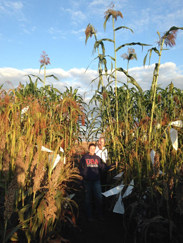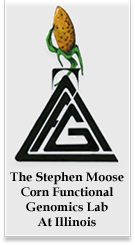Broomcorn Breeding
History of Broomcorn
 Broomcorn (Sorghum vulgare var. technicum) is a type of sorghum chosen for its utility in the broom-making industry. It was introduced to the United States in the early 1700’s and spread to the northeastern states. Illinois was the number one producer starting in the 1860s with production centered near Arcola, IL. More than a decade later production has dropped to 100,000 acres nationwide and a majority of broomcorn used for production in the United States is imported from Mexico. Current breeding efforts are focused on germplasm retention, viability of mechanical harvest, and improved broom quality traits for production.
Broomcorn (Sorghum vulgare var. technicum) is a type of sorghum chosen for its utility in the broom-making industry. It was introduced to the United States in the early 1700’s and spread to the northeastern states. Illinois was the number one producer starting in the 1860s with production centered near Arcola, IL. More than a decade later production has dropped to 100,000 acres nationwide and a majority of broomcorn used for production in the United States is imported from Mexico. Current breeding efforts are focused on germplasm retention, viability of mechanical harvest, and improved broom quality traits for production.
Broomcorn Physiology
Ideally, broomcorn lines have an extended panicle with the seed set congregated at the very end of the panicle. The branches of the panicle would begin at the peduncle with minimal fusing of the central branches. These varieties are well suited for mechanical harvesting, after which the seed is removed and the panicle straw is woven into brooms. The microhairs on the end of the straw act to capture dust particles while the thicker portion of the panicle provides support for the broom.

Gene Discovery and Molecular Breeding
 Over the past 40 years, broomcorn improvement at UIUC has relied heavily on field breeding for desired harvest and broom quality traits. Our objective now is to use high throughput genotyping to generate high confidence single nucleotide polymorphisms (SNPs) on the available phenotypic variation within broomcorn. Using this information, we aim to identify loci that contribute to the variation observed in broom quality and agronomic traits. Further assessment of these loci can help to elucidate the genes involved in inflorescence architecture and could aid in the improvement of broomcorn lines through the use of marker assisted selection. From these SNPs we can also access the genetic differentiation between the broomcorn sorghum types with traditional sweet sorghum and grain sorghum lines.
Over the past 40 years, broomcorn improvement at UIUC has relied heavily on field breeding for desired harvest and broom quality traits. Our objective now is to use high throughput genotyping to generate high confidence single nucleotide polymorphisms (SNPs) on the available phenotypic variation within broomcorn. Using this information, we aim to identify loci that contribute to the variation observed in broom quality and agronomic traits. Further assessment of these loci can help to elucidate the genes involved in inflorescence architecture and could aid in the improvement of broomcorn lines through the use of marker assisted selection. From these SNPs we can also access the genetic differentiation between the broomcorn sorghum types with traditional sweet sorghum and grain sorghum lines.
The Nolan Broomcorn Trust
We want to thank the Nolan Broomcorn Trust for their support and inspiration. None of this work could be done without them.
